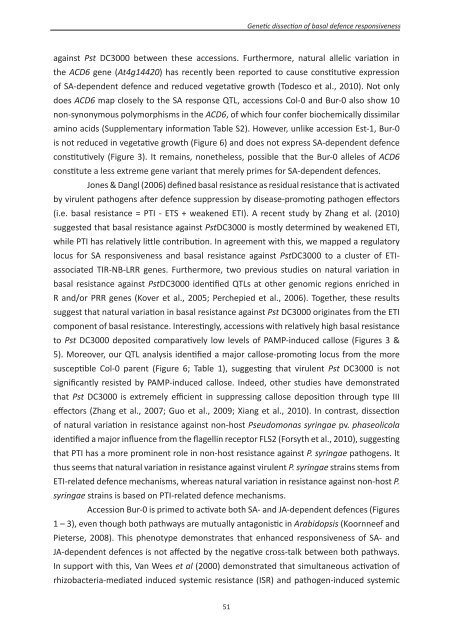Plant basal resistance - Universiteit Utrecht
Plant basal resistance - Universiteit Utrecht
Plant basal resistance - Universiteit Utrecht
You also want an ePaper? Increase the reach of your titles
YUMPU automatically turns print PDFs into web optimized ePapers that Google loves.
51<br />
Genetic dissection of <strong>basal</strong> defence responsiveness<br />
against Pst DC3000 between these accessions. Furthermore, natural allelic variation in<br />
the ACD6 gene (At4g14420) has recently been reported to cause constitutive expression<br />
of SA-dependent defence and reduced vegetative growth (Todesco et al., 2010). Not only<br />
does ACD6 map closely to the SA response QTL, accessions Col-0 and Bur-0 also show 10<br />
non-synonymous polymorphisms in the ACD6, of which four confer biochemically dissimilar<br />
amino acids (Supplementary information Table S2). However, unlike accession Est-1, Bur-0<br />
is not reduced in vegetative growth (Figure 6) and does not express SA-dependent defence<br />
constitutively (Figure 3). It remains, nonetheless, possible that the Bur-0 alleles of ACD6<br />
constitute a less extreme gene variant that merely primes for SA-dependent defences.<br />
Jones & Dangl (2006) defined <strong>basal</strong> <strong>resistance</strong> as residual <strong>resistance</strong> that is activated<br />
by virulent pathogens after defence suppression by disease-promoting pathogen effectors<br />
(i.e. <strong>basal</strong> <strong>resistance</strong> = PTI - ETS + weakened ETI). A recent study by Zhang et al. (2010)<br />
suggested that <strong>basal</strong> <strong>resistance</strong> against PstDC3000 is mostly determined by weakened ETI,<br />
while PTI has relatively little contribution. In agreement with this, we mapped a regulatory<br />
locus for SA responsiveness and <strong>basal</strong> <strong>resistance</strong> against PstDC3000 to a cluster of ETI-<br />
associated TIR-NB-LRR genes. Furthermore, two previous studies on natural variation in<br />
<strong>basal</strong> <strong>resistance</strong> against PstDC3000 identified QTLs at other genomic regions enriched in<br />
R and/or PRR genes (Kover et al., 2005; Perchepied et al., 2006). Together, these results<br />
suggest that natural variation in <strong>basal</strong> <strong>resistance</strong> against Pst DC3000 originates from the ETI<br />
component of <strong>basal</strong> <strong>resistance</strong>. Interestingly, accessions with relatively high <strong>basal</strong> <strong>resistance</strong><br />
to Pst DC3000 deposited comparatively low levels of PAMP-induced callose (Figures 3 &<br />
5). Moreover, our QTL analysis identified a major callose-promoting locus from the more<br />
susceptible Col-0 parent (Figure 6; Table 1), suggesting that virulent Pst DC3000 is not<br />
significantly resisted by PAMP-induced callose. Indeed, other studies have demonstrated<br />
that Pst DC3000 is extremely efficient in suppressing callose deposition through type III<br />
effectors (Zhang et al., 2007; Guo et al., 2009; Xiang et al., 2010). In contrast, dissection<br />
of natural variation in <strong>resistance</strong> against non-host Pseudomonas syringae pv. phaseolicola<br />
identified a major influence from the flagellin receptor FLS2 (Forsyth et al., 2010), suggesting<br />
that PTI has a more prominent role in non-host <strong>resistance</strong> against P. syringae pathogens. It<br />
thus seems that natural variation in <strong>resistance</strong> against virulent P. syringae strains stems from<br />
ETI-related defence mechanisms, whereas natural variation in <strong>resistance</strong> against non-host P.<br />
syringae strains is based on PTI-related defence mechanisms.<br />
Accession Bur-0 is primed to activate both SA- and JA-dependent defences (Figures<br />
1 – 3), even though both pathways are mutually antagonistic in Arabidopsis (Koornneef and<br />
Pieterse, 2008). This phenotype demonstrates that enhanced responsiveness of SA- and<br />
JA-dependent defences is not affected by the negative cross-talk between both pathways.<br />
In support with this, Van Wees et al (2000) demonstrated that simultaneous activation of<br />
rhizobacteria-mediated induced systemic <strong>resistance</strong> (ISR) and pathogen-induced systemic

















